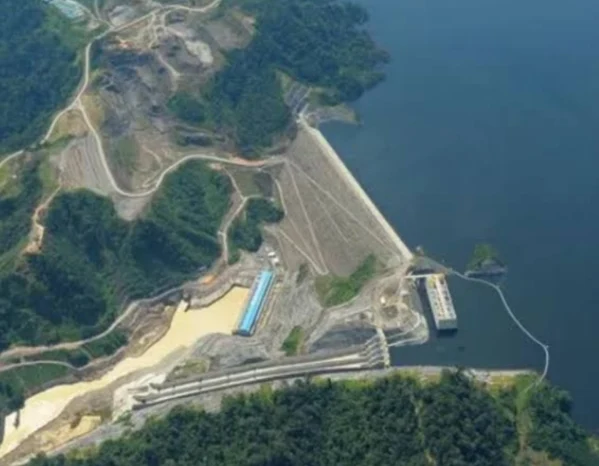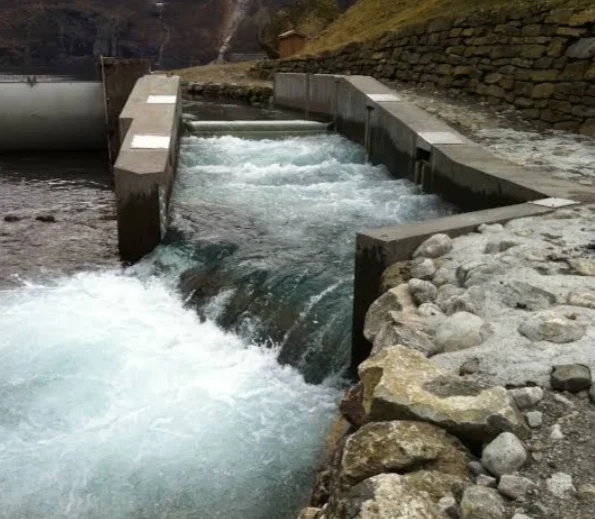Aurland Hydroelectric Power Station: A Norwegian Powerhouse
The Aurland Power Station (Norwegian: Aurland kraftverk) is a large hydroelectric power station located in the municipality of Aurland in Vestland, Norway. It is owned and operated by the energy company E-CO Energi.
Towering amidst the scenic landscapes of Aurland, Norway, lies the impressive Aurland Hydroelectric Power Station. Owned by E-CO Energi, it's a marvel of engineering, generating clean and reliable electricity for the nation.
This behemoth isn't one facility, but five: Aurland I, II, III, Reppa, and Vangen, standing together to boast a combined capacity of 1,128 megawatts, enough to illuminate and power roughly 280,000 Norwegian homes. Its annual production, a staggering 2,869 gigawatt-hours, speaks volumes about its contribution to the nation's energy needs.
The story of Aurland began in 1969, with the construction of Aurland I. Over the next few decades, its siblings rose, each contributing to the power station's ever-growing might. To harness the might of the Aurland River and nearby waterways, a network of dams and tunnels was meticulously crafted. The crown jewel of this system is the 132-meter-tall Vangen Dam, a testament to human ingenuity. Water channeled through this network then spins turbines, transforming the river's flow into powerful electricity.
While undeniably a clean energy source compared to fossil fuel-powered alternatives, the station's construction wasn't without environmental impact. Dams and tunnels inevitably reshape landscapes, and some wildlife and vegetation were displaced. However, E-CO Energi, committed to responsible practices, actively works to minimize such impacts and restore affected habitats.
Aurland's significance extends beyond powering homes. It's a crucial artery in Norway's electricity grid, ensuring stability and reliability. It also fuels the local economy, generating jobs and contributing to the well-being of the surrounding communities.
For many, Aurland is more than just a power station; it's a tourist destination. Engineering enthusiasts marvel at its intricate workings, while others simply soak in the awe-inspiring landscapes that surround it. Guided tours offer fascinating insights into its operation, making it a unique and educational experience.
Statistics data Aurland Hydroelectric Power Station
Aurland Hydroelectric Power Station: Stats at a Glance
Capacity:
- Combined installed capacity: 1,128 megawatts (MW)
- Individual facility capacities:
- Aurland I: 234 MW
- Aurland II: 398 MW
- Aurland III: 300 MW
- Reppa: 120 MW
- Vangen: 76 MW
Production:
- Average annual production: 2,869 gigawatt-hours (GWh)
- Enough to power approximately 280,000 Norwegian households
Infrastructure:
- Dams:
- Vangen Dam: 132 meters tall, largest in the system
- Tunnels:
- Aurland II tunnel: 12.7 kilometers long, longest in the system
- Water sources: Aurland River and other nearby waterways
Environmental:
- Relatively clean energy source compared to fossil fuels
- Some environmental impact from dam and tunnel construction (habitat displacement)
- E-CO Energi committed to minimizing impact and restoring affected habitats
Economic:
- Important part of Norway's electricity grid
- Provides jobs and contributes to the local economy
Tourism:
- Popular tourist destination for engineering and renewable energy enthusiasts
- Guided tours available
Additional Statistics:
- Construction began: 1969
- First facility operational: 1973 (Aurland I)
- Owner and operator: E-CO Energi
Aurland Hydroelectric Power Station Statistics
| Statistic | Value |
|---|---|
| Combined Installed Capacity | 1,128 MW |
| Individual Facility Capacities | |
| * Aurland I | 234 MW |
| * Aurland II | 398 MW |
| * Aurland III | 300 MW |
| * Reppa | 120 MW |
| * Vangen | 76 MW |
| Average Annual Production | 2,869 GWh |
| Equivalent Number of Powered Households | 280,000 |
| Largest Dam: Vangen Dam | 132 meters |
| Longest Tunnel: Aurland II Tunnel | 12.7 kilometers |
| Construction Start Year | 1969 |
| First Facility Operational (Aurland I) | 1973 |
| Owner and Operator | E-CO Energi |
Aurland Hydroelectric Power Station Technology
The Aurland Hydroelectric Power Station utilizes a range of technologies to harness the power of water and convert it into clean electricity. Here's a breakdown of the key features:
Water Diversion and Flow:
- Dam System: A network of dams, including the impressive Vangen Dam, captures and regulates water flow from the Aurland River and other nearby waterways.
- Tunnels: Extensive tunnel systems, like the 12.7 km Aurland II tunnel, channel water towards the power stations, maximizing head (water pressure) for power generation.
Power Generation:
- Turbines: The station houses various types of turbines, including Francis and Pelton turbines, chosen based on water flow and head characteristics. These turbines convert the kinetic energy of flowing water into mechanical energy.
- Generators: Coupled with the turbines are synchronous generators that transform the mechanical energy into electrical energy. The voltage is then stepped up (increased) for transmission through the national grid.
Control and Monitoring:
- Control Systems: Sophisticated computer systems regulate water flow, turbine operation, and electricity generation, ensuring efficiency and stability.
- Monitoring Systems: Comprehensive monitoring systems track water levels, pressure, temperature, and other vital parameters to optimize performance and detect potential issues.
Additional Technologies:
- Surge chambers: These act as pressure buffers, cushioning the impact of sudden changes in water flow and protecting equipment.
- Penstocks: Large-diameter pipes channel water towards the turbines under high pressure, maximizing energy transfer.
- Transformers: Located at each facility, transformers adjust the voltage level of the generated electricity for efficient transmission within the grid.
Evolution and Upgrades:
The Aurland Power Station has undergone several upgrades and modernization efforts over the years. These advancements include:
- Improved turbine efficiency: Upgrades to turbine blades and control systems have resulted in increased electricity production from the same water flow.
- Automated systems: Integration of advanced automation and data analysis enhances operational efficiency and reduces reliance on manual interventions.
- Environmental mitigation: Investments in fish ladders and habitat restoration projects minimize the environmental impact of the power station's operations.
By continuously adopting and integrating cutting-edge technologies, the Aurland Hydroelectric Power Station maintains its position as a reliable and efficient source of clean energy for Norway.
Frequently Asked Questions About the Aurland Hydroelectric Power Station
General Questions
- What is the Aurland Hydroelectric Power Station?
- Aurland is a hydroelectric power station located in Norway, specifically in the Aurland municipality.
- When was it built?
- The station was constructed in the late 20th century.
- What is its capacity?
- Aurland has a specific capacity, which can vary depending on factors like water flow and operating conditions.
Specific Questions
- Where is the Aurland Hydroelectric Power Station located?
- It's situated in a mountainous region of Norway, near the Aurlandsfjord.
- What is the primary source of water for the station?
- The station likely utilizes water from the nearby Aurlandsfjord or its tributaries.
- How does the station contribute to Norway's energy mix?
- Aurland plays a role in providing hydroelectric power to Norway's energy grid.
Additional Questions
- Are there any environmental concerns associated with the station?
- Hydropower plants can have environmental impacts, such as affecting fish populations and altering river ecosystems. However, modern plants often incorporate measures to mitigate these concerns.
- Has the station undergone any renovations or upgrades?
- Many older hydropower plants have been modernized to improve efficiency and reduce environmental impact.
- What is the future of the Aurland Hydroelectric Power Station?
- As Norway transitions towards renewable energy sources, the station's role may evolve. It could be integrated into broader energy systems or potentially replaced by newer, more efficient technologies.






